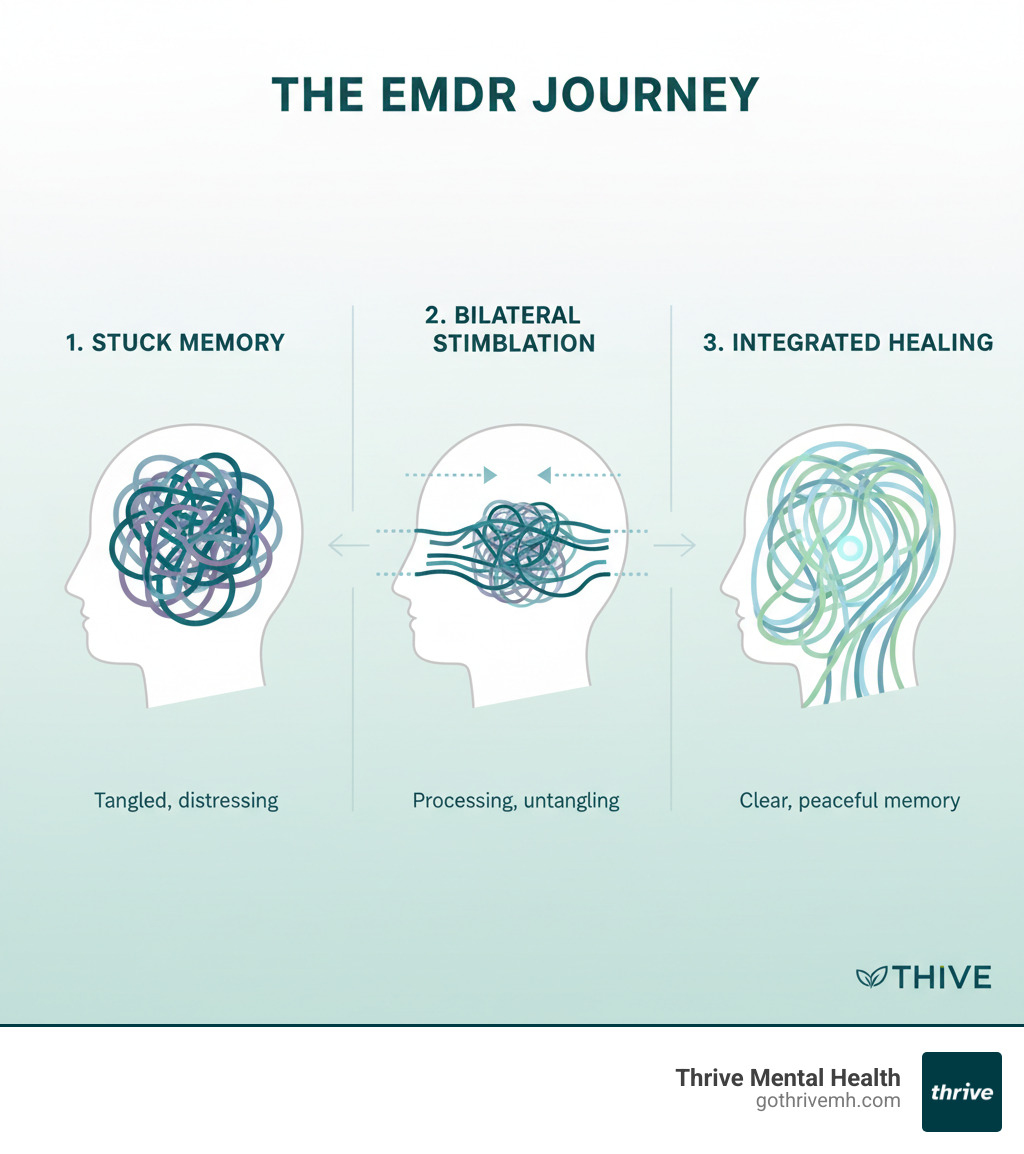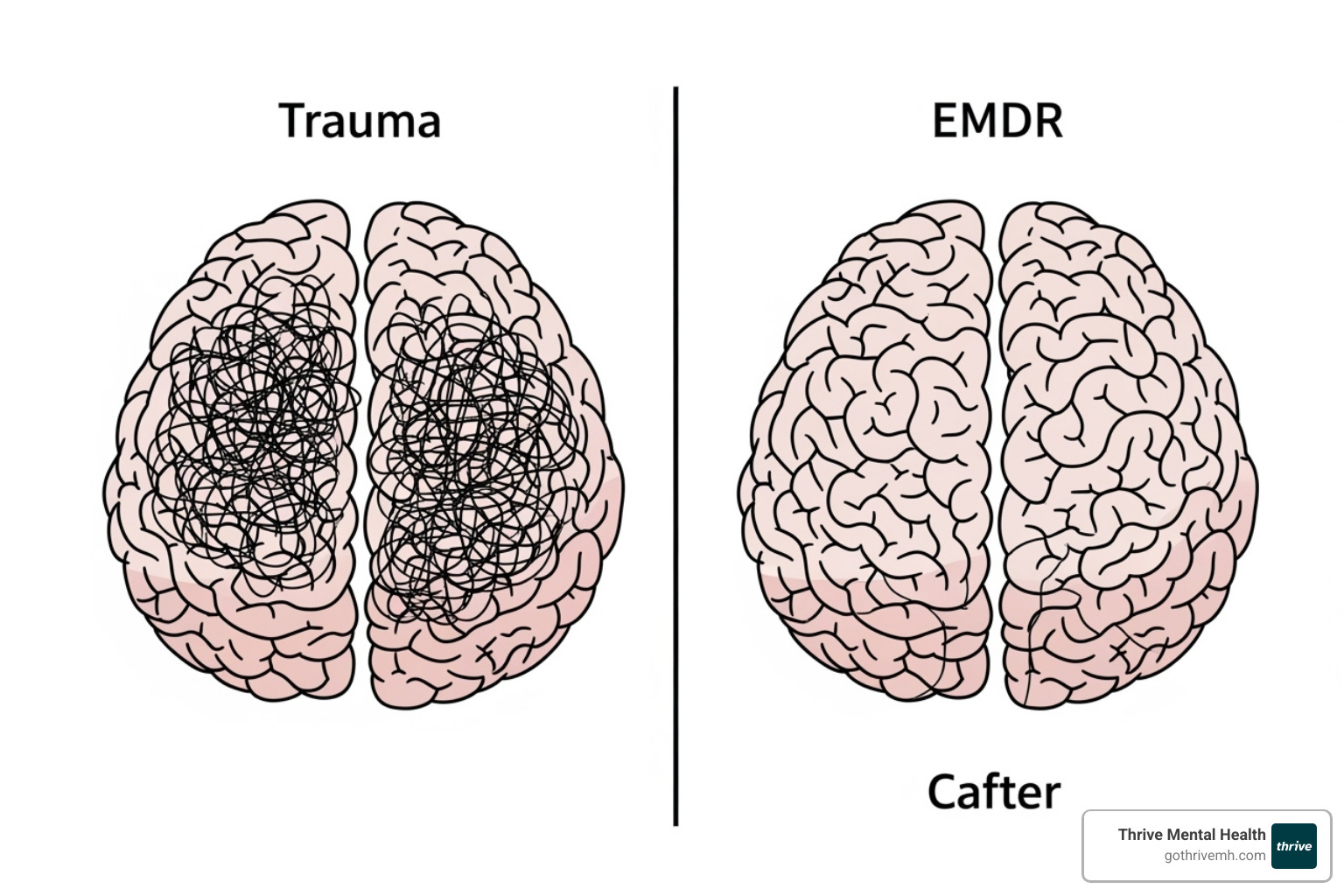Swipe Right on Your EMDR Therapist – A Guide to Finding the Best Fit

Emdr Therapist: Find Your Best Fit 2025
Your Path from Trauma to Triumph Starts Here
Struggling with trauma, anxiety, or PTSD makes finding the right emdr therapist feel overwhelming. The good news is you don’t have to steer this journey alone.
Quick Answer: What to Look for in an EMDR Therapist
- Licensed mental health professional (LMHC, LPC, LCSW, or psychologist)
- EMDR training completion through EMDRIA or EMDR Institute
- Good personal fit – you feel safe and understood
- Experience with your specific concerns (trauma type, age group)
- Clear communication about treatment approach and expectations
EMDR (Eye Movement Desensitization and Reprocessing) is a powerful, evidence-based therapy that helps your brain reprocess stuck traumatic memories using bilateral stimulation (like guided eye movements), a different approach from traditional talk therapy.
Research shows impressive results: 84-90% of single-trauma victims no longer had PTSD after just three 90-minute sessions. The World Health Organization and American Psychiatric Association both recommend EMDR as a first-line treatment for trauma.
However, therapist quality varies. This guide will help you find a qualified professional who is the right fit for your healing. As Chief Clinical Officer at Thrive Mental Health, a leading provider of EMDR therapy in Florida, and a licensed therapist with specialized EMDR training, I’ve seen how the right therapeutic relationship accelerates healing. This guide will show you how to find it.

Similar topics to emdr therapist:
What is EMDR and Why Does It Work So Fast?
Crisis Support: If you are in crisis or having thoughts of self-harm, please call or text 988 to reach the Suicide & Crisis Lifeline. You are not alone, and help is available 24/7.
When trauma occurs, the memory can get “stuck” instead of being properly filed away by your brain. This is why painful emotions can flood back as if the event just happened.
How Trauma Gets “Stuck” in Your Brain
The Adaptive Information Processing (AIP) model explains this. Normally, your brain processes experiences during sleep. Trauma can overload this system, leaving the memory stuck and emotionally charged, complete with the original sights, sounds, and feelings.

This is why flashbacks, triggers, and feelings of reliving the trauma occur—your brain is stuck in “danger” mode even when you’re safe.
The Magic of Bilateral Stimulation
During EMDR, your therapist uses bilateral stimulation (like guided eye movements, alternating tapping, or auditory tones) while you focus on the memory. This process mimics REM sleep, activating your brain’s natural healing ability.
Crucially, you are reprocessing, not reliving, the trauma. Instead of retelling the story, you’re allowing your brain to file the memory correctly, so it becomes part of your past, not a painful part of your present.
Why EMDR Works So Remarkably Fast
EMDR works fast because it leverages your brain’s natural healing process. Scientific research confirms its speed: 84-90% of single-trauma survivors found relief from PTSD after just three 90-minute sessions. For complex trauma, 77% of individuals recovered after 6-12 sessions.
These aren’t just statistics—they represent real people reclaiming their lives. The World Health Organization, American Psychiatric Association, and U.S. Department of Veterans Affairs all recommend EMDR as a first-line treatment for trauma because the evidence is so compelling.
An emdr therapist helps your brain understand the danger has passed, allowing you to move forward with strength.
For more insights into how this powerful approach works, check out our guide on Eye Movement Therapy: A Pathway to Emotional Wellness.
The 8 Phases of EMDR: What to Expect in Your Sessions

EMDR therapy follows a structured, eight-phase approach designed to keep you safe and in control. Think of it as building a solid foundation for healing, one step at a time. Here’s a brief overview of what to expect:
-
Phase 1: History-Taking and Treatment Planning
In this initial phase, your therapist takes a thorough history to understand your background, identify current struggles, and collaboratively create a treatment plan. You’ll identify potential target memories that are the source of your distress. -
Phase 2: Preparation (Resource Building)
Safety first. Your therapist equips you with essential coping skills, such as grounding techniques and visualization exercises (like creating a “safe place”). This ensures you feel prepared and in control before processing traumatic memories. -
Phase 3: Assessment (Target Memory)
You and your therapist will select a specific target memory to work on. You’ll identify the disturbing image, the negative self-belief it created (e.g., “I am not safe”), and a positive belief to replace it (e.g., “I am safe now”). You’ll rate your distress level to establish a baseline for tracking progress. -
Phase 4: Desensitization (Bilateral Stimulation)
This is the core processing phase. While holding the target memory in mind, your therapist guides you through sets of bilateral stimulation (eye movements, taps, or tones). Your brain does the work of making new connections, and you simply notice what comes up. The emotional charge of the memory gradually fades. -
Phase 5: Installation (Positive Belief)
With the memory’s distress level lowered, you’ll focus on strengthening the positive belief you identified in Phase 3. More bilateral stimulation helps “install” this new, adaptive belief, making it feel true on an emotional level. -
Phase 6: Body Scan
Your therapist will guide you through a body scan to check for any lingering physical tension or discomfort associated with the memory. If any remains, further bilateral stimulation is used to release it, ensuring the healing is complete. -
Phase 7: Closure
At the end of each session, your therapist ensures you feel stable and grounded, whether a memory is fully processed or not. You’ll use your coping skills to “close” the session, leaving you feeling contained and prepared for the time between appointments. -
Phase 8: Re-evaluation
At the beginning of subsequent sessions, your therapist will re-evaluate the work from previous sessions. This ensures that the healing is holding, the distress remains low, and the positive belief is still strong before moving on to the next target.
This structured, eight-phase approach ensures your healing journey is safe, paced, and effective, keeping you in control at all times.
Exploring EMDR Therapy Techniques for Trauma Recovery.
Is EMDR Right for You? [Conditions, Benefits & Risks]

While renowned for treating Post-Traumatic Stress Disorder (PTSD)—with studies showing 84-90% of single-trauma victims no longer meet PTSD criteria—EMDR’s benefits extend much further. An emdr therapist can effectively treat:
- Anxiety disorders, including panic attacks and phobias.
- Depression, especially when linked to past negative experiences.
- Eating disorders, grief, chronic pain, and performance anxiety.
Essentially, if your struggles are rooted in distressing memories, EMDR may be a powerful solution. Beginners Guide to Understanding Trauma
Why People Choose EMDR Therapy
People often choose EMDR for its unique benefits:
- Faster Results: Many experience relief in weeks, not years.
- Less ‘Homework’: The core work happens during your session.
- Gentler Processing: You reprocess memories without having to relive every painful detail.
- Lasting Change: By changing how the brain stores traumatic memories, EMDR addresses the root problem, not just the symptoms.
Understanding the Risks and Limitations
It’s important to be aware of potential risks. You might experience temporary distress or notice new memories surfacing between sessions; this is a normal part of the brain’s healing process. A skilled emdr therapist will prepare you with coping tools.
EMDR is not a fit for everyone and requires caution with active substance use, active psychosis, or severe, unmanaged dissociative disorders. Always discuss your full health history with your therapist.
The evidence is clear: The World Health Organization, American Psychiatric Association, and U.S. Department of Veterans Affairs all endorse EMDR as a first-line treatment for trauma.
Evidence for EMDR’s effectiveness for PTSD
How to Find a Qualified EMDR Therapist [Checklist]
Finding a qualified emdr therapist is crucial for successful healing. The quality of training and experience matters, so it’s important to look beyond a simple “EMDR” listing on a website.
Understanding Credentials: EMDRIA vs. EMDR Institute
You’ll encounter two main training bodies: EMDRIA (EMDR International Association) and the EMDR Institute. While both offer valid training, EMDRIA Certification represents a higher level of proficiency.
| Feature | EMDRIA Certified Therapist | EMDR Institute Trained Clinician |
|---|---|---|
| Training | Completed EMDRIA-approved basic training | Completed basic training through EMDR Institute |
| Experience | Requires 50+ EMDR sessions with 25+ clients | May have varying clinical experience levels |
| Consultation | Requires 20 hours of consultation with approved supervisor | Post-training consultation not required |
| Continuing Education | Ongoing EMDR-specific education required | Encouraged but not formally required |
| Proficiency Level | Demonstrates higher proficiency and protocol adherence | Has foundational knowledge but may be newer to complex cases |
An EMDRIA Certified Therapist has completed extensive post-training consultation and has more verified experience. While not always necessary, this certification provides an extra layer of confidence in your therapist’s expertise.
Using Online Directories to Find an EMDR therapist
Use online directories to streamline your search:
- The EMDRIA Directory: The gold standard for finding certified and trained therapists.
- The EMDR Institute Directory: Another reliable source for trained clinicians.
- Psychology Today: A popular general directory with filters for EMDR, location, and insurance.
When searching, filter by location, specialization (your specific concerns), and insurance to create a manageable list of candidates.
Verifying Your EMDR therapist’s Credentials
Before committing, do your due diligence:
- Verify State License: Check the Florida Board of Clinical Social Work, Marriage & Family Therapy and Mental Health Counseling website to ensure they are a licensed mental health professional in good standing in Florida.
- Confirm EMDR Credentials: Use the EMDRIA directory to verify certification.
- Ask Questions: During a consultation, ask about their training, experience with cases like yours, and if they receive ongoing consultation. A qualified emdr therapist will welcome these questions.
Considering Virtual EMDR Therapy for Accessibility
Research confirms that virtual EMDR therapy is just as effective as in-person sessions. Online therapy offers incredible accessibility and convenience, allowing you to connect with the right specialist from the comfort of your home. This is especially beneficial for those in areas with few local options, making it possible to find expert care from anywhere in Florida, including Miami, Orlando, Tampa, and Jacksonville. Ensure any online therapist uses a secure platform and has experience with virtual EMDR delivery.
Choosing the Right EMDR Therapist: Tips and Considerations
Paying for EMDR Therapy: Insurance Coverage & Costs

Understanding the cost of therapy is a key part of planning your healing journey. Here’s what you need to know about paying for EMDR.
Understanding EMDR Therapy Costs
The cost of EMDR therapy varies by location and therapist experience, typically ranging from $100 to $200+ per session. Virtual sessions may be more affordable, often between $65 and $150, due to lower overhead for the practice.
Insurance Coverage: What You Need to Know
The good news is that most major insurance plans cover EMDR therapy, as it’s recognized as a first-line treatment for PTSD.
- In-Network: This is your most affordable option. You’ll typically only pay a copay or coinsurance.
- Out-of-Network: Many plans still reimburse 50-80% of the cost after you meet your deductible. Your therapist can provide a “superbill” (a detailed receipt) for you to submit to your insurance company.
Major Insurance Providers and EMDR Coverage
In Florida, major providers like Florida Blue, Cigna, Aetna, Optum, and UnitedHealthcare often cover EMDR. Always call your insurance provider and ask:
- What is my copay/coinsurance for mental health services?
- Have I met my deductible?
- Do you cover out-of-network services, and at what percentage?
At Thrive Mental Health, we help our Florida clients verify their benefits to make the process as smooth as possible.
Making EMDR Affordable: Alternative Options
If individual sessions are a financial concern, consider an intensive outpatient program (IOP) or partial hospitalization program (PHP). These programs often include EMDR and can be a more cost-effective way to receive comprehensive care. Virtual Intensive Outpatient Programs can be especially accessible and affordable.
Navigating Mental Health Support with Aetna and UnitedHealthcare
Frequently Asked Questions about Finding an EMDR Therapist
Here are answers to some of the most common questions about finding an emdr therapist and starting treatment.
How many sessions of EMDR does it take to work?
The number of sessions depends on your history. For a single traumatic event, many people find significant relief in just 3-6 sessions. For complex or multiple traumas, 8-12 sessions or more may be needed to achieve full resolution. Your therapist will create a plan custom to you.
Is EMDR better than CBT for trauma?
Both EMDR and Cognitive Behavioral Therapy (CBT) are considered “gold standard” trauma treatments recommended by the World Health Organization. The best choice depends on you. EMDR is often preferred by those who find it difficult to talk about their trauma in detail, as it requires less verbal processing and no homework.
Can EMDR make you feel worse?
It’s possible to feel a temporary increase in distress between sessions as your brain processes difficult material. This is a normal part of healing, like cleaning a wound. A qualified emdr therapist will give you coping skills to manage this discomfort and ensure you feel supported throughout the process.
Can you do EMDR therapy online?
Yes, absolutely. A growing body of research confirms that online therapy for EMDR is just as effective as in-person treatment. It offers greater flexibility and access to specialists, allowing you to receive care from the comfort and privacy of your own home. At Thrive Mental Health, we successfully provide virtual EMDR to clients across Florida, from the Panhandle to the Keys.
Take the Next Step Toward Healing
Finding the right emdr therapist is a powerful step toward reclaiming your life from trauma. With success rates showing 84-90% of single-trauma survivors no longer meeting PTSD criteria after just a few sessions, EMDR offers a proven path to healing. You have the tools to find a qualified professional who fits your needs. You deserve to feel safe, calm, and free from the past.
Ready for support in Florida? Thrive Mental Health offers virtual and hybrid IOP/PHP with evening options, making expert care accessible across the state. Verify your insurance in 2 minutes (no obligation) → Start benefits check or call 561-203-6085. If you’re in crisis, call/text 988.